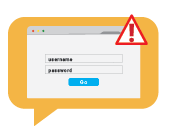Remote Work Phishing Attack Prevention.
What You Need to Know
With many people now remote working, phishing threats are targeting workers and preying on unfamiliar routines, technology learning curves and distracted employees.
Phishing Tactics are Increasing Every Day
Phishing emails are out there, bypassing technical safeguards, such as secure email gateways, and leveraging human vulnerabilities to infect your network.
They use social engineering tactics to trick you into opening an attachment, clicking a link to get credentials, or downloading a malicious file.
Popular Phishing Email Examples
- Virtual Meeting Platforms
- Workplace Policy Emails
- VPN/Password Updates
- HR Communications
Helpful Remote Work Phishing Resources
Stay Cyber-Safe while Working Remotely
Examine the URL
If you click a URL that directs you to a login page, look at the URL to ensure it’s correct.

Keep Passwords Safe
Your IT Department won’t ask you for your password over email. Same goes for any reputable company.
john_smith
********
Think Twice
Attackers will use emotional appeals. Stay calm and look closely at the email for grammar or typos.

Report It
If there’s a real threat, your security team won’t know unless you notify them. That’s true wherever your office is.

Remote Work Phishing Emails are Bypassing Email Gateways
Real Phishing Examples Caught by Cofense-powered Humans. Click Image to Enlarge.







